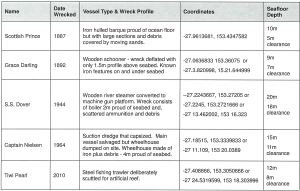By Paddy Waterson
It’s always exciting, and a bit nerve racking, when you get a new piece of ‘kit’. Will it be easy to put together? Will it work as well as you hoped? Will it enable you to achieve the results you have promised? You have probably seen the same piece of equipment at work and know the basics, but the onus is on you now and there are always tricks to be learnt.
In 2013, the Queensland Department of Environment and Heritage Protection invested in a new Geometrics G882 Marine Magnetometer to assist with the Queensland Historic Shipwreck Survey (QHSS). The QHSS is a five year initiative to update official records on the state’s estimated 1400 historic shipwrecks. The size of the state, and the number of historic shipwrecks, means that the fieldwork component of the survey is aimed at locating, identifying and documenting wrecks in key strategic areas, such as Moreton Bay. The initial phases of fieldwork in the QHSS used an existing side scan sonar system and had been quite successful in locating a number of wrecks. However, it soon became apparent that we need something more. The dynamic nature of the Queensland coast made locating many timber wrecks problematic, largely because they are constructed from materials that are extremely vulnerable to deterioration in the marine environment and so tend to have a lower physical profile. This is compounded by Queensland’s offshore environment that is a mixture of dense corals, thick muds and highly mobile sand, all of which can significantly inhibit the effectiveness of visual and side scan sonar searches for low profile historic shipwrecks. A business case for a magnetometer was subsequently developed and the G882 was purchased using funds from the Commonwealth Historic Shipwrecks Program—now I just have to make it work!
A project was developed to configure and test the magnetometer in local conditions to ensure we achieved the best potential outcomes when it was deployed across the state. This project has two phases:
- The initial testing of the magnetometer on five known shipwrecks to determine its operational limits and develop a signature profile guide for different wreck types.
- Conducting preliminary research into two previously un-located wrecks in the Moreton Bay Region.
The initial testing phase will use five known wrecks within the greater Moreton region. These wrecks were chosen for their comparative signature profile testing, as they are a good representative sample of the different wreck types commonly encountered along the Queensland coast. The test wrecks range in type from a small wooden schooner and a large iron hulled barque, through to steel hulled trawler. By comparing the different magnetic signatures of the wrecks, and their relative detection ranges, we will be able to refine future survey methods and better interpret results when searching for previously un-located historic shipwrecks.

Table 1. Details of the five wrecks used to test the magnetometer, build a signature profile and refine search methods. These wrecks were chosen due to their variation in size, physical profile and construction materials.
The initial configuration and preliminary tests were conducted in November 2013. The hardware configuration for the magnetometer was relatively simple, as it came correctly calibrated for the region. Some minor assembly was required, but this was quickly achieved with the support of staff from Marine Sciences and the Queensland Parks and Wildlife Service.
The Geometrics G882 Marine Magnetometer
The magnetometer being deployed from the Queensland Marine Parks vessel Caretta. Assisting are Ranger Rohan Couch (left) and Technical Officer James Fels (right).
The initial software configuration proved more challenging, as the magnetometer software was configured to integrate the GPS data via a ‘pin-port’ rather than the more common USB connection—this was resolved through the acquisition of an additional ‘pin-port’ aerial output cable. The use of a specialised laptop that could cope with the movement of the vessel was also essential—many laptops simply lock up the hard drive when vibration is detected.
The laptop, data junction box and GPS configured and ready for deployment.
With the initial set-up and preliminary systems testing complete the surveys of the known wrecks could commence—and a new range of challenges could begin. More on that in my next blog.

